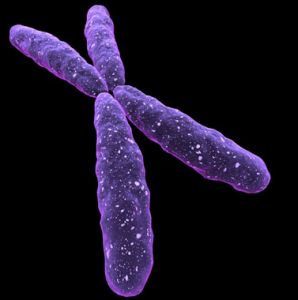

MedFriendly®


X-Linked Inheritance (Characteristic)
An x-linked characteristic is a trait that is associated
with a gene carried on the X chromosome, which gets
its name because it is shaped like the letter “X.”
Chromosomes are structures made of protein that
contain genes. Genes are units of material contained in
a person's cells that contain coded instructions as for
how certain bodily characteristics (such as eye color)
will develop. All of a person's genes come from his/her
parents. There are about 1100 human x-linked genes.
Any trait associated with a gene on the X chromosome
will always be expressed in males because they only
have one X chromosome (women have two). Men also
have a Y chromosome but women do not.
The X-chromosome.
FEATURED BOOK: Genes, Chromosomes, & Diseases
This holds true regardless if the gene is dominant or recessive. A gene that masks the
effect of another gene is called a dominant gene. The gene whose expression is masked
is known as a recessive gene. An example of an x-linked characteristic is color-
blindness. Some disorders are passed on through the X chromosome such as red-green
color blindness and male pattern baldness. This is because the genes needed to
differentiate red from green are located on the X chromosome. A male with an abnormal
color vision gene on the X chromosome will develop red-green color blindness because
there is no gene on the Y chromosome to mask its effect. By contrast, a woman with only
one abnormal color vision gene would not develop color blindness if she had a normal
color vision gene on the other X chromosome because it would mask the effect of the
abnormal gene.
"Where Medical Information is Easy to Understand"™
Due to this masking effect of the second X chromosome, women
are often carriers of X-linked mutations without expressing it
physically. Only girls receive x-linked chromosomes from their
fathers. Boys get the X chromosome from the mother because they
must get the Y chromosome from the father. Thus, if a man has an
abnormal recessive gene and his mate does not, none of the boys
will get the gene because they do not inherit his x chromosome.
However, the gene will be passed on to his daughters, who will now
become carriers (known as obligate carriers) for the x-linked
condition but they will not express the condition (except for mild
manifestations in some instances). The abnormal recessive X-linked
abnormal recessive gene must be present on each X chromosome
of the female for her to express the full characteristic or condition.
Hemophilia (impaired blood clotting) is another example of an x-linked disorder. Another example is
Duchenne’s muscular dystrophy. Duchenne's muscular dystrophy is a condition present in childhood in
which leg and hip muscles continuously waste away. Rarely, a female can express and x-linked recessive
disease if she inherits the same abnormal x-linked gene from both parents. If a mother only has one
abnormal x-linked recessive gene, a male child would have a 50% chance of having the disorder because
only one of the two X chromosomes from the mother will be passed on. A female child in this instance
would also have a 50% of inheriting the inheriting the abnormal gene (because one of the girl’s genes
comes from the mother) and becoming a carrier. Males can sometimes be the first person in a family with
an x-linked condition due to a mutation.















